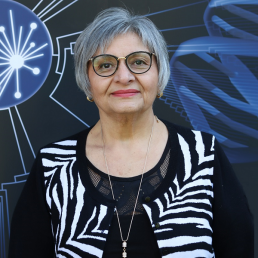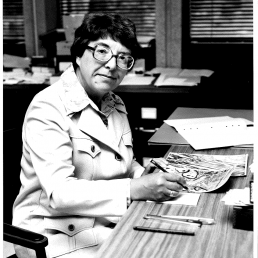Health and Safety is Front and Centre in Award for Lisa Matchett from USW 1998
Gentle reminders and firm requirements are the ways Lisa Matchett keeps our labs and offices safe. For her actions on Health and Safety, she has earned the 2020 Health and Safety Award from United Steelworkers Local 1998. This award recognizes the outstanding performance of a U of T staff member in USW 1998 who works towards fostering and promoting health, safety, and environmental issues in their workplace.
When new regulations are instituted that are difficult to envision in a laboratory environment, Matchett works out implementations that keep our workplace functioning safely. She displays a proactive and preventative commitment to health and safety with posted reminders by our elevators and inspections throughout our buildings. Her clear and unambiguous instructions promote continuous improvement of health and safety in the workplace and encourages others to initiate health and safety policies and procedures.
Thank you, Lisa, and congratulations on your Award!
Collaboration and Innovation by Prof Nicholas Provart earns a Highly Cited Researcher award
Nicholas J Provart, CSB Professor and Chair, has earned a Highly Cited Researcher award for 2020 from Clarivate Web of Science. His publications in journals including Science, Nature and Plant Cell were in the top 1% by citations world-wide for the field of Plant & Animal Science. Provart is one of only four Canadian researchers to earn this award in Plant & Animal Science.
Provart’s research interest is developing computational tools and analyses for plant biology, along with wet-lab validation of gene regulatory networks revealed using these tools. Citations are an indication that other researchers are referencing his work and using the tools that Provart invented. One of his most highly cited recent papers is “ePlant: Visualizing and Exploring Multiple Levels of Data for Hypothesis Generation in Plant Biology“. You can experiment with this tool at the Bio-Analytic Resource.
Provart exemplifies the collaborative nature of science by partnering with many different research groups. He has applied his innovative computational techniques to collaborations on rice, wheat, maize and poplar. His studies have resulted in novel insights on polyploidy, seed germination and plant hormone response.
Congratulations, Nick!
Splicing and remixing coded cellular messages reveals new controls on nervous system development.
The Calarco lab in Cell & Systems Biology at U of T has unveiled the signals that direct how RNA messages are remixed within the diverse organs of an animal in a new publication “Global regulatory features of alternative splicing across tissues and within the nervous system of C. elegans”. When a gene is turned on, it produces a messenger RNA (mRNA) that is translated to make a protein. But in moving from DNA to translation, the message can be remixed by splicing to produce a range of similar proteins with different purposes the way a music producer splices together different music tracks for the same song.
As RNA is produced from DNA, the linear protein coding ‘exons’ have ‘introns’ between them. Like cutting out unnecessary dialogue in a music track, splicing removes the intron, resulting in an mRNA of spliced-together exons. Some exons are not included in the final mRNA in all cells, and these remixes are termed “alternatively spliced (AS)”. Using a new approach for enriching mRNA from specific cell types, the Calarco lab extracted RNA from different tissues and individual sets of brain cells of the nematode worm C. elegans and then selected all the sequences that showed alternative splicing.
Bina Koterniak, a Ph.D. student in the lab, then analyzed this database of sequences to find patterns in the RNA codes that resulted in alternative splicing. Intriguingly, Koterniak’s analysis identified hundreds of novel AS transcripts both across tissues and even in specific brain cells of the animal. This process thus generates a remarkable amount of diversity even in an organism with a compact nervous system.
Fellow graduate student Pallavi Pilaka selected a few of those short codes from multiple genes that appeared to be specific to muscle or nervous system tissue. Koterniak and Pilaka, the co-lead authors on this study, noticed that a protein-RNA interaction site specific to the UNC-75/CELF protein was present in many of the AS transcripts.
By creating a mash-up of the coded RNA and an RNA for coloured fluorescent proteins, they made some cells light up red and others green depending on the code contained in the spliced region. Remarkably, diverse colour patterns in individual tissues and brain cells could be observed in live animals. Pilaka was surprised and excited to see that for genes with a mutated UNC-75/CELF binding site, the green signal was greatly reduced. This mechanism is thought to occur due to splicing repression by UNC-75/CELF via interactions with the splice site.
With this information, Calarco’s lab could delve deeper into the patterns in AS RNA and try to infer the regulation behind these patterns. Koterniak was happy to have such a large dataset to work with, as it yielded not just deep knowledge of AS sequences, but also broad representation of different tissues.
By teaming up with Iva Pritišanac, a postdoctoral fellow in the labs of Alan Moses and Julie Forman-Kay, Koterniak found that AS exons more often overlapped with and encoded intrinsically disordered regions in proteins. Moreover, AS exons are often shorter than non-AS exons but are flanked by longer intron sequences, likely impacting how they are recognized by the splicing machinery. Their studies yielded a further surprise that among these tissue-regulated exons are several microexons only 3-27 nucleotides in length. These microexons were found in other species of worm, indicating that they were conserved through millions of years of evolution. “The conservation is not just in the spliced exon, but spreads out into adjacent introns, and it was exciting to see these signatures in genes with tissue-biased exon splicing patterns” notes Pallavi.
Calarco summarizes that “our results overall show that these features associated with AS exons are conserved with striking similarities to vertebrates, making C. elegans a great model system to better understand this critical layer of gene regulation. We are getting an indication of universal evolutionary constraints shaping the genes and protein regions affected by alternative splicing. An important goal will be to further explore how these conserved AS exons are affecting the proteins they encode and ultimately what impact this diversity has on cellular function, particularly in the nervous system.”
Alumna Manal Siddiqui receives Arbor Award for her dedicated mentorship of CSB and HMB students
It is always a joy to see our alumni return to guide current students. One of our alumna, Manal Siddiqui (BSc, Vic 0T6) has received a 2020 Arbor Award for being a dedicated mentor to students in CSB and in the Human Biology (HMB) Program.
Siddiqui was an HMB student and conducted research in Professor Ashley Bruce’s lab. Since graduating, she has mentored a number of CSB undergrad and grad students. They greatly appreciate her willingness to always be available to answer their questions and to provide guidance. One example of Siddiqui's dedication is that almost a decade after graduating, she sat for an interview when she was Manager at Clinical Trials Ontario to help undergraduates understand her career progression. She is currently Director, Health Strategic Partnerships at the Vector Institute.
Thank you for your mentorship!
Janet Mannone reveals her greatest challenge over 35 years at U of T
Janet Mannone is the Undergraduate Coordinator for CSB, and an expert at responding to the needs of students. She consults, informs and encourages educators within CSB to give our students the best course possible. Her actions refine the remit of our courses and knit our disparate programs together.
This month, Mannone has been recognized for 35 years of service to U of T, and she combines that experience with a commitment to excellence. She has navigated many difficult transitions over 35 years at U of T, but says that her greatest challenge was learning new administrative systems in a web-based environment as they were being developed.
This experience was useful as the pandemic hit in March 2020, ending in-person classes. With tenacity, extensive consultation and a commitment to comprehensive outcomes, she facilitated the department's roll out of online teaching in a short period of time.
We congratulate our valued colleague Janet on her 35 Long Service Award!
Remembering Professor Mike Barrett
It is with sadness that we learned that Professor F Michael Barrett passed away last week. He was an accomplished entomologist who had an important role in supporting our students and making them feel welcome. In CSB and our predecessor, the Department of Zoology, Mike Barrett was a force for collegiality, fairness, and a focus on individual students as well as the student body as a whole.
Barrett taught over 500 undergraduates a year in small and large courses with great care and concern for students. His support is behind the F Michael Barrett Award that recognizes excellence from undergraduate researchers.
His consideration for students was applied to course design and curriculum development across campus. Undergraduate Coordinator Janet Mannone remembers "Mike was able to concern himself with the big picture, such as the quality of our undergraduate programs while focusing on the small details, such as fine tuning course descriptions for the Arts and Science Calendar."
Within the Department, Barrett always worked to raise up others. He submitted nominations for staff awards and advocated for promotion of junior faculty. Professor Ellie Larson asserts that "He was an energetic force for 'improvement' in the department and society, where his stature increased without pushing anyone else down."
Barrett's early teaching duties included courses on reproduction, which lead to decades of involvement in the field of human sexuality. He had a particular interest in promoting the sexual health and wellbeing of people with disabilities. Barrett was Executive Director of the Sex Information and Education Council of Canada (SIECCAN) and Editor of the Canadian Journal of Human Sexuality from 1992 to 2016.
Please follow the link for more details from his family and friends on his "generous, compassionate and loving nature".
CSB's Tamar Mamourian recognized for 35 years of outstanding service to U of T
Everyone in Cell & Systems Biology is familiar with the smiling face and focused tone of our Chief Administrative Officer Tamar Mamourian. She is always available to facilitate solutions to a problem, suggest more sensible alternatives, or sometimes just listen.
Tamar combines her keen perceptions with a deep understanding of the workings of the University that comes from 35 years of service. That service has been recognized by the University through the 35 Long Service Award. This Award recognizes the role she has played in the success of our institution, her commitment to excellence, and cites the benefits her efforts have yielded for her colleagues and our students.
We give our warmest congratulations to our cherished colleague, Tamar Mamourian.
In Memoriam: Professor Betty Ida Roots
The University of Toronto Community lost an eminent scholar on October 24th with the passing of Professor Betty Ida Roots, PhD, DSc, FRSC. She served the University in a number of roles; as Professor at U of T from 1969, Assistant Chair of Zoology beginning in 1972, Associate Dean of Science at UTM (then Erindale College) from 1976 and Chair of the Department of Zoology (now CSB and EEB) from 1984-1990. Roots planned, established, and directed the Electron Microscope Facility at UTM. One of her many lasting legacies is the collaborative Ph.D. program in Neuroscience at the University of Toronto, which she initiated and developed. Her friend Professor Ellie Larsen describes her as “not only a successful scientist but also a very fine leader”.
Breaking barriers: Quebec platelet disorder
A decade after the discovery that Quebec Platelet Disorder is caused by a tandem duplication, the Mitchell laboratory and collaborators demonstrate that this causes the additional copy of the duplicated PLAU gene to be on the opposite side of a CTCF genomic boundary. As a consequence, the extra copy is not insulated from the effects of a transcriptional enhancer of the adjacent VCL gene, resulting in a high level of transcription. This phenomenon is known as “enhancer hijacking”.
Read More Here
This research has been published as "Enhancer-gene rewiring in the pathogenesis of Quebec platelet disorder"
Building excellence in research and teaching: CSB’s new Chair Nicholas Provart
Professor Nick Provart likes building things; he even used his carpentry skills to expand his children’s treehouse while working from home (without losing any fingers). As the new Chair of the Department of Cell & Systems Biology (CSB), he now has the opportunity to build up the academic excellence of the Department.
Building on the strength infused into CSB by the previous Chair, Vincent Tropepe, Provart will guide a department that is world class in life sciences, research, and teaching initiatives. When considering his new role, he also received valuable advice from previous Chairs Daphne Goring and John Coleman.
Provart started at University of Toronto in 2002 as an early leader in data science at the Department of Botany (now part of CSB). His laboratory established the Botany Affymetrix Resource (BAR), developing user-friendly techniques and tools for visualizing genome-wide, tissue-specific gene expression that have evolved along with the latest advances in genomics technology.
CSB is building on this Departmental expertise in data science by developing a Professional Masters in Biological Data Science. Provart anticipates this will provide benefits to graduates in finding jobs in labs, agencies or startups, and will provide productive cross-fertilization with graduate students working at the lab bench.
Provart feels “fortunate to be part of a pretty diverse and inclusive Department, University, and City”. Along with ensuring diversity of hires, he will encourage presenting a wide range of voices to be heard as speakers inside and outside the Department.
Provart has been teaching online since 2014. When in-person lectures moved online due to COVID-19, he adapted quickly to delivering his Bioinformatic Methods course entirely online. He shares his extensive experience in online instruction as a Fellow in the Faculty of Arts & Science’s Online Learning Academy.
“I hope I will be able to help CSB and other faculty across Arts & Science get up to speed in terms of pivoting to online learning this fall” Provart says. Once in-person classes return, he will strengthen CSB’s experiential learning opportunities in upper level courses and through the Bioinformatics and Computational Biology program at CSB.
Provart believes the CSB has a “hugely important” role in promoting science outside the University, through supporting organizations like Let’s Talk Science and iGEM Toronto. “From my perspective, it was amazing to see the interest of the public at last year’s Science Rendezvous”, an outdoor science festival where CSB presented its science alongside other U of T Departments. “These community building and outreach efforts are an important aspect to us as scientists.”
Congratulations to CSB’s new Chair, Nicholas Provart!









